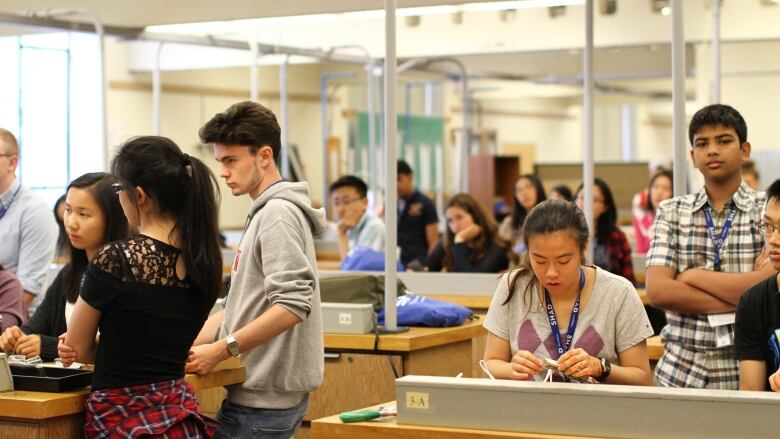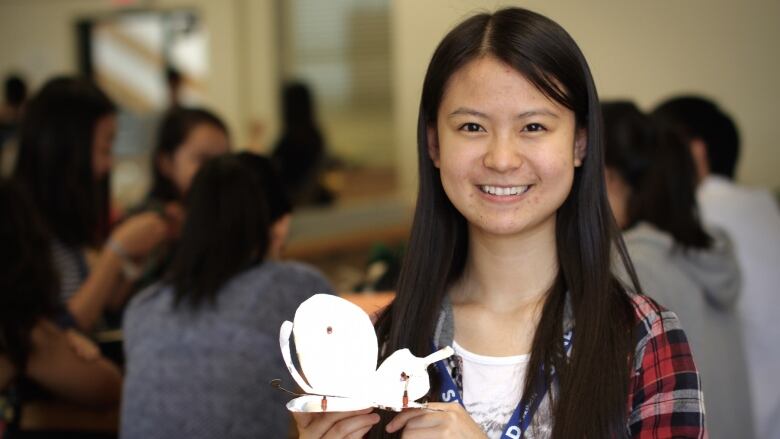Teens tasked with improving Canada's food security
Each summer, the SHAD program brings accomplished teens together to promote innovation

Can high school students help improve Canada's food security? That's the challenge for a few hundred teens taking part in this year's SHAD program.
The program, which has been running each summer since 1980, draws 'exceptional' students together from across the countryfor a month packed with lectures, labs, learning, and other types of programming.
- PHOTOS:B.C. high school students heading to world robotics competition
- B.C. teenager wins top prize at international science fair
- TED Talks In Vancouver
- CBC Ideas:TEDTalks - The Next Greatest Generation?
About 700 students are sent to 12 Canadian university campuses, where they live in residence and eat, drink, and breathe SHAD.
The 2016session has just kicked off, and at the University of British Columbiaabout 60 students have just been been introduced to the topicfor this year's main project: food security.
"This year's theme is to develop a product or service to ensure Canada's food security going forward," said SHAD UBC program director and engineering professor DaanMaijer.

"At the end of the month, they're responsible for delivering a business plan, a prototype or a mockup of what their product will be, as well as a pitch."
Maijer explained that the emphasis is on STEM science, technology, engineering, and math along with entrepreneurship. But students are selected for the program based on a much broader criteria, including arts, sports,community service and 'soft skills.'
Carl Pinterhas just finished up Grade 11 in Moose Jaw, Sask. He applied for the program because he wanted to get a bit of a taste ofuniversity before he finished up high school.

"At first I was really scared because I didn't know exactly what I was getting into and who I'd meet," he said."But after that first day of adjusting I felt really at home at the residence and with the people that I'm with."
The students or shadlings as they'recalled by SHAD staff have to complete an exhaustive application process. According to Maijer, half of applicants aren't accepted and many more are dissuaded by the application process.
Prospective shadlings have to write a series of personal essays. Pinter wrote one about the three years he spent living with acutelymphoblastic leukaemia.

"To get in, yeah it is a rigorous process," said Pinter."Not only do we have to deal with these essays and the whole application process, it does cost some money. I was lucky enough to get a bursary, but my family still had to pay some."
Fellow shadlingZhouhang (Amy) Daitravelled to Vancouver from Saint John, New Brunswick. She's also going into Grade 12.
"I have a friend who came to SHAD last year," she said. "She told me it was amazing to see all the bright-minded people across Canada who all have a passion for the STEM ...and also entrepreneurship tokind of gather and spring ideas off each other and tocreate a product that potentially might solve a problem."

Dai and Pinter have been assigned to groups to tackle the problem of food insecurity and the same groups will work on various other projects and tasks throughout the month.
This week, the students were told to create a kinetic art piece.
"Our team is trying to build a butterfly that would flap its wings when people pass by or go near," said Dai, noting that the butterfly will rely on ultrasonic sensors like a bat to detect passers by.
"I made a template for the butterfly and I helped with programming a bit," she said.
Pinter'sgroup was working on a hand with moving fingers. It will also use an ultrasonic sensor.

"It's been hard work, but it's been great. We have a really great team working together and just seeing all the parts come together is wonderful," he said.
But thereal challenge still lies ahead. The teams have only had a little time to get together and brainstorm about Canada's food systems. Once the shadlingsdecide where the major problems lie, they'll have to come up with solutions.
"I'm a bit nervous, but I think we'll put out something that's really good," said Pinter.

It's a daunting task for anyone, but these Grade 10, 11, and 12 students just may be up to it.
The SHAD UBC staff will determine which group has the strongest product and pitch, and then that group will have to face off against the best ideas from each of the other 11 campuses.
Follow Rafferty Baker on Twitter: @raffertybaker












_(720p).jpg)


 OFFICIAL HD MUSIC VIDEO.jpg)
.jpg)



























































































